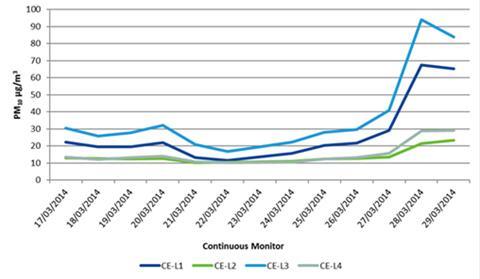… unless there’s Saharan sand outside

The issue of air quality received national attention earlier this year as London and much of the rest of country was exposed to the Saharan sands. The red dust effect this created provided an interesting media narrative and created for all of us a rare tangible reminder of the impact of poor air quality (see graph below), with an increase in asthma attacks and emergency calls.
Yet this was a rare example; Britons should feel safe opening their windows, including in major cities.
In my role as head of WSP’s London building services business I am actively encouraging clients to open windows. Considering that our climate is remarkably mild, the UK is particularly bad at opening itself to the cool weather outside.
For years we have sealed our buildings to reduce energy and avoid cooling our cities (by losing chilled air out the window), using fan coil units to stabilise the temperature. I bet if you are in a big commercial office reading this you will struggle to find a window you can open.

Four continuous monitoring locations showing spike in air pollution (CE-L1 to L4) at Central London. 24-hour mean PM10 concentrations (µg/m3) between 17-30 March 2014
These days, however, we have reduced internal loads - lighting and computers - so much that using outside air to create comfortable conditions is now a real possibility. The air temperature in the UK is 19oC and below for 90% of the year, so we should use it.
The mayor of London does need to take bold and politically brave decisions
What’s more it’s free. And reducing our dependency on chiller loads at peak time will go a long way towards meeting carbon reduction targets and tackling grid supply shortages.
Industry environmental standards like BREAMM and CEEQUAL that continue to set the bar higher and regulations that set increasingly stringent carbon reduction targets will necessitate change in the way we design and build. So we should embrace natural and mixed-mode ventilation as an efficient way of achieving these targets.
We should also seize this moment to fight pollution and turn this opportunity into reality. We do not need measures as drastic as Paris, where cars with odd and even number plates are banned on alternate days. However, the mayor of London does need to take bold and politically brave decisions.
For example, my colleague David Symons has pointed out three good policy options, including: making all black cabs and London buses running in London zero emission by 2020; making the existing Low Emission Zone zero emission by 2020; and making London’s homes and businesses much more energy efficient through a recommitment to the Green Deal and Energy Companies Obligation schemes.
These policies will unquestionably help to reduce pollution by removing and reducing combustion related fumes in London. Then we can start to create the virtuous circle: opening our windows will mean there is less of a need to turn on the air conditioning, further saving energy, the environment, and money.
This is not going to happen overnight, but I passionately believe this is a fundamental change that has to be made in the industry, and advances in technology and changes to the economic climate mean we should putting our innovative ideas to clients now.
My message is clear, let’s not be afraid to open our windows.
Nick Offer is London head of building services at WSP



























![2753-KINGSLEYCLARKE-3377 (1)[11] copy](https://d3sux4fmh2nu8u.cloudfront.net/Pictures/100x67/1/1/2/2000112_2753kingsleyclarke3377111copy_616752_crop.jpeg)
No comments yet